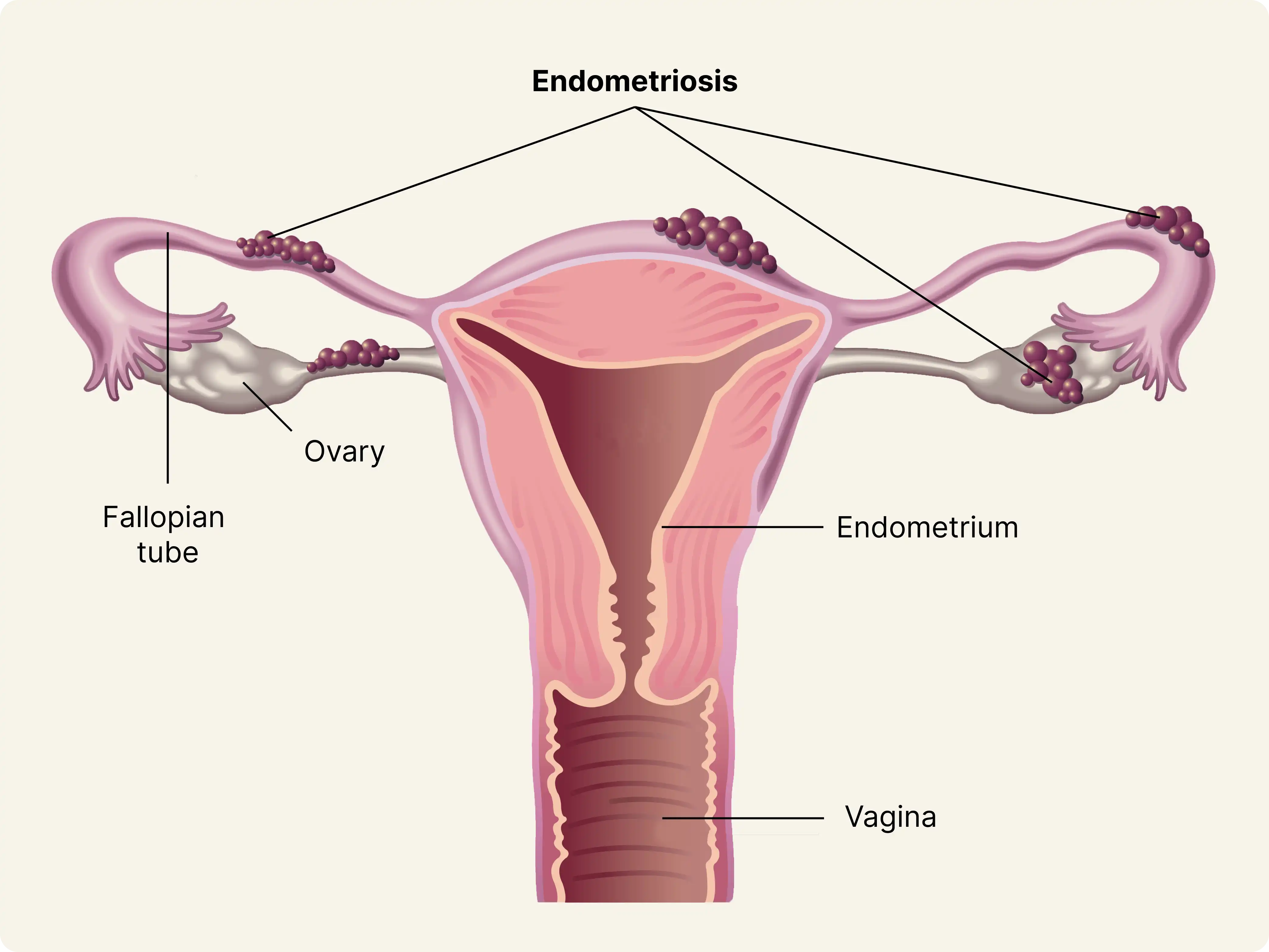What is Endometriosis?
Endometriosis is a condition where the tissue that lines the uterus (Endometrium) grows outside of the uterus. It affects between 2 and 10 percent of reproductive age women, according to Johns Hopkins.
The endometrium that grows outside of the uterus is known as an adhesion.
The growth of this tissue on, around, or in other organs like the fallopian tubes and ovaries can affect their function and contribute to infertility.
Endometriosis is a condition where the tissue that lines the uterus (endometrium) grows outside of the uterus.
Symptoms of Endometriosis
Endometriosis can have a range of symptoms, from mild to severe, that interfere with many aspects of a person’s life. The most common symptoms are:
moderate to severe menstrual cramps
heavy periods
infertility or difficulty getting pregnant
pain during intercourse
Some less common symptoms that arise as a result of the endometrial tissue growing on the bladder and bowels are diarrhea and painful urination during your period.
Endometriosis pain can be debilitating, so it’s important to discuss your symptoms with your doctor to confirm your diagnosis and determine your treatment options.
Diagnosing Endometriosis
Doctors diagnose endometriosis a few different ways:
Patient reported symptoms
Transvaginal ultrasound
Endometrial biopsy
Laparoscopic surgery
Patient Reported Symptoms
When speaking with your doctor, be sure to share how you’re feeling. Do you experience pain or very heavy bleeding during your period? Have your menstrual cramps become increasingly more painful over time? These are symptoms that your doctor can use to help determine if you may be suffering from endometriosis.
Transvaginal Ultrasound
Another way to diagnose endometriosis is through Transvaginal Ultrasound. Here, the doctor uses the ultrasound to visualize adhesions.
Depending on the size and location of the adhesions, they may not be able to be visualized by ultrasound.
Endometrial Biopsy
One way your doctor may want to diagnose endometriosis is through an endometrial biopsy. To complete this test, your doctor will insert a small straw-like instrument into the vagina and go through the cervix and into the uterus to remove a small sample of tissue. The sample of tissue is sent to the lab to be examined for certain cell markers that are diagnostic for endometriosis.
Laparoscopic Surgery
Another way to diagnose endometriosis is to actually visualize the adhesions through a minor surgical procedure called a Laparoscopy. This method is also one of the ways to treat endometriosis.
How is Endometriosis Treated?
Laparoscopic Surgery
As discussed, laparoscopic surgery is one of the ways to both diagnose and treat endometriosis.
For endometriosis, this type of surgery is called a laparoscopic lysis of adhesions, which means to break up and remove the overgrowth of endometrial tissue.
Laparoscopic surgery is done with a few very tiny incisions in the abdomen. Using these incisions, the doctor will use a camera to visualize the inside of the abdominal cavity and find adhesions caused by endometriosis. Then the doctor can use surgical instruments to remove the tissue. Unfortunately, this procedure doesn’t cure the endometriosis, but it does get rid of the existing adhesions that are contributing to the pain. Oftentimes, the adhesions will come back over time.
Medications to Treat Endometriosis
Another way to treat endometriosis is to take medications that stunt the growth of the endometrial tissue. The main options are hormonal birth control pills, an Intrauterine Device, or ovarian suppression medications. Each of these medications work differently, but all are methods of stunting the growth of the endometrium both inside and outside of the uterus, which prevents the tissue from overgrowing.
Pain Management
One of the most common ways to treat endometriosis is to treat the painful symptoms that it causes. Non-steroidal Anti-inflammatory Drug pain relievers like ibuprofen work best for this type of pain (Always be sure to check with your doctor before taking any new medications). Some cases cause severe enough pain that prescription pain medications are prescribed.
Make sure to discuss with your doctor if you have severe pain with your periods that is not controlled using over the counter pain medication. It may require further assessment by your doctor to determine and treat the cause of the severe menstrual pain.
Getting Pregnant with Endometriosis
People with endometriosis can get pregnant on their own, but oftentimes they may need help from a fertility specialist. One of the main considerations with endometriosis and trying to get pregnant is investigating whether your fallopian tubes are blocked.
Divya Kelath Shah, MD, MME, spoke about this in an interview with PennMedicine. “Some women with macroscopic disease may have lesions and scar tissue that can block the fallopian tubes,” Dr. Shah said. “This can make it difficult for the egg to make its way into the uterus.”
Depending on the location and stage of your endometriosis, there are different treatments recommended. For instance, if your fallopian tubes are blocked and sperm cannot reach the egg, In Vitro Fertilization will likely be the best option for you. If your tubes are clear, your doctor may suggest starting with a low intervention fertility treatment like Intrauterine Insemination (IUI).
Check out these articles if you want to learn more about IVF and IUI.
Each person and each pregnancy is different. Your doctor will help you to decide based on your health, age, and stage of endometriosis what type of treatment may work best for you.
Endometriosis is a condition that affects many people. It varies drastically in severity and knowing what symptoms to look out for, and your options for treatment, can help you to navigate your health and fertility journey.
Sources:
“Endometriosis and Fertility: Three Reasons for Women to Have Hope.” 2022. Pennmedicine.org. 2022..
Johns Hopkins Medicine. 2019. “Endometriosis.” Johns Hopkins Medicine. 2019.

